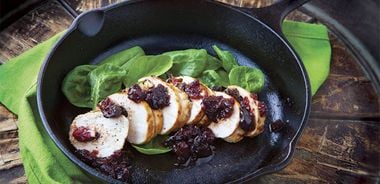Stuffed Chicken Breasts with Cherry Glaze

Makes 4 servings
Animal studies indicate cherries can help lower cholesterol and triglyceride levels. Pairing them in a recipe with cherry vinegar makes for an extraordinarily nutritious dish!
6 Tbsp (120 ml) dried cherries, divided
1/4 cup (60 ml) salt-reduced chicken stock
4 skinless, boneless chicken breast halves
115 g soft goats’ cheese, crumbled
Freshly ground black pepper, to taste
3 tsp (15 ml) extra-virgin olive oil, divided
2 tsp (10 ml) butter
6 small shallots, chopped
1 1/2 Tbsp (30 ml) cherry vinegar
1 tsp (5 ml) honey
Freshly grated nutmeg
Preheat oven to 375 F (190 C).
In small bowl, combine 3 Tbsp (60 ml) cherries with chicken stock; set aside to soak.
Remove the tiny fillet from the underside of each chicken breast half. Make vertical cut down length of each breast (but not all the way through) to form small pocket.
In small bowl, mix crumbled cheese with remaining 3 Tbsp (60 ml) cherries. Stuff an equal amount of mixture into each chicken breast pocket, sprinkle with freshly grated black pepper and cover with reserved fillet. Secure fillet in place by tying cooking string around each breast.
Heat well-seasoned cast iron frying pan on medium heat. Add 1 tsp (5 ml) olive oil to pan and sear breasts on each side for 3 minutes, until golden. Transfer pan to oven and bake 15 minutes or until chicken is cooked through. Remove string before serving.
For the glaze, heat remaining olive oil and butter in small frying pan. Sauté shallots until soft and golden. Add vinegar, stock and cherries and simmer until mixture begins to thicken slightly. Add honey and a sprinkle of freshly grated nutmeg; warm through.
Pour warm glaze over prepared chicken breasts and serve atop sautéed greens such as spinach or silverbeet.
Each serving contains: 1369 kilojoules; 33 g protein; 12 g total fat (6 g sat. fat, 0 g trans fat.); 20 g total carbohydrates (14 g sugars, 1 g dietary fibre); 197 mg sodium
source: "Virtuous Vinegar", alive Australia #19, Autumn 2014




